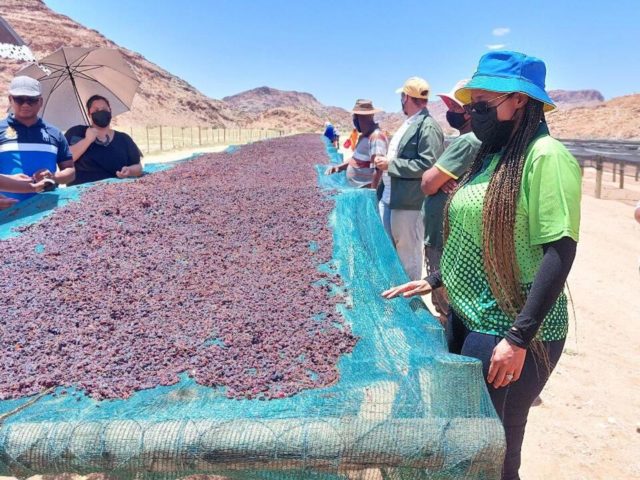The Northern Cape vineyard belt has created more jobs for the 2021/22 production season as grape production rises to greater heights.
THE NORTHERN Cape vineyard belt has created more jobs for the 2021/22 production season as grape production rises to greater heights.
With the harvesting and drying of grapes season under way, South Africa is forecasting a crop of 78,000 tons of marketable raisin grapes for the 2021/22 production season, of which a remarkable 90% is grown in the Northern Cape.
The Northern Cape Department of Agriculture, Environmental Affairs, Rural Development and Land Reform noted that the past 2020/21 season saw a sharp decrease of 16% due to unfavourable weather conditions last year.
More than 30,000 people work full-time in the South African raisin industry, in the Orange River Valley Vineyard belt.
An employment peak of 30,000 to 35,000 seasonal workers was experienced during the harvesting and drying of grapes in the ZF Mgcawu and Namakwa districts.
The MEC for Agriculture, Environmental Affairs, Rural Development and Land Reform, Mase Manopole, recently embarked on an oversight visit to assess provincial government-funded vineyard projects, which are mainly found along the Orange River.
Projects like the Richtersveld CPA, the Pella Irrigation Project, Onseepkans Irrigation Development Project, Voordekop, Bloecosso and Eksteenskuil have received more than R500 million combined in government support over the years.
Manopole expressed pride in some of the projects for showing significant growth over the years.
The MEC highlighted that her visit to some of these projects was to ascertain whether the money that the government has invested has been put to good use.
“If one considers an average household size of five individuals, then the total reach of the SA raisin industry (indirectly) impacts 150,000 individuals. The total economic output of the same is estimated at R2 billion annually, which also importantly earns foreign currency for the national economy as 90% of all produce is exported,” said Manopole.
“These are important stats for a rural, poor province and perhaps the raisin industry should be considered as a provincial asset in many ways.
“Yes, there are challenges here and there, which we are aware of, but through the assistance of our district managers and extension officers we are able to overcome those challenges.
“We need to embark on a vigorous and intensified programme of skills development, so that when the time comes for the government to exit the projects, as strategic investors, we leave behind well-oiled machinery that will take the projects to greater heights.”
Manopole used the department’s partnership with Raisins South Africa, which saw the launch of a 200-hectare raisin development in Eksteenskuil in 2013/14, as an example.
“This has seen significant volume growth of previous production levels of 800 tons to levels now exceeding 2,000 tons. In monetary terms, the same community now annually earns an approximate R45 million, compared to R15 million in 2013/14.
“Similar BEE initiatives have also seen the growth of black participants in the industry.”
Raisins South Africa chief executive officer Ferdie Botha said the South African raisin industry has doubled over the past eight years thanks to the Orange River Valley Vineyards belt contribution.
“With various private and public sector developments, volumes have grown from approximately 40,000 tons (2011/12) to 85,000 (2019/20) and are expected to reach levels of 100,000 tons as early as 2023/24. This is mainly attributed to improved profitability levels, driven by improved production levels,“ said Botha
He said market access and development are key strategic priorities for the SA raisin industry to ensure markets are also grown as production expands in time.
“Currently, Raisins SA is running five market development campaigns, in the UK, Germany, France and South Africa.
“There is a strong global drive for improved healthier lifestyles, with Covid-19 further strengthening such drive. This global consumption trend provides an opportunity to grow global raisin consumption over the next decade.
“Raisins provide several options and a healthy snack option, it is a versatile product that can be used in a wide variety of food products as a natural sweetener, is an affordable product and is naturally preserved through drying of the fresh grapes,” said Botha.
The Orange River has experienced high flows since January 2022 with above average rainfall experienced upstream in both the Vaal and Orange catchment regions.
The recent high flow levels have negatively impacted 2% to 3% of the total hectares, with water levels that have decreased since January 2022.
“This being said, for such individual’s losses might be significant, although limited to the larger industry as a whole.
“Eksteenskuil in particular has suffered some losses. The OR region has also experienced some rainfall on the 30th and 31st of January 2022.
“The crop has developed well until now, with minor damages suffered to the crop at the start of spring when some frost and hail occurred. At the present moment, we have not yet seen the necessity to decrease the crop forecast.
“There is still a long harvest and drying period that is ahead of us, as final product delivery to processors usually concludes towards the end of April.”
Internationally, the supply and demand situation of raisins remains in balance at levels of 1.3 million tons. Turkey is the largest producer of raisins, producing approximately 300,000 tons annually. The US was previously the dominant player, but has since the early 2000s reduced production output from levels of 350,000 tons to levels of 200,000 tons.
South Africa currently produces 7% of world production, but plays a more prominent role in terms of global exports as 90% of SA’s production is destined for international markets, with the EU representing 51% market share of exports.








